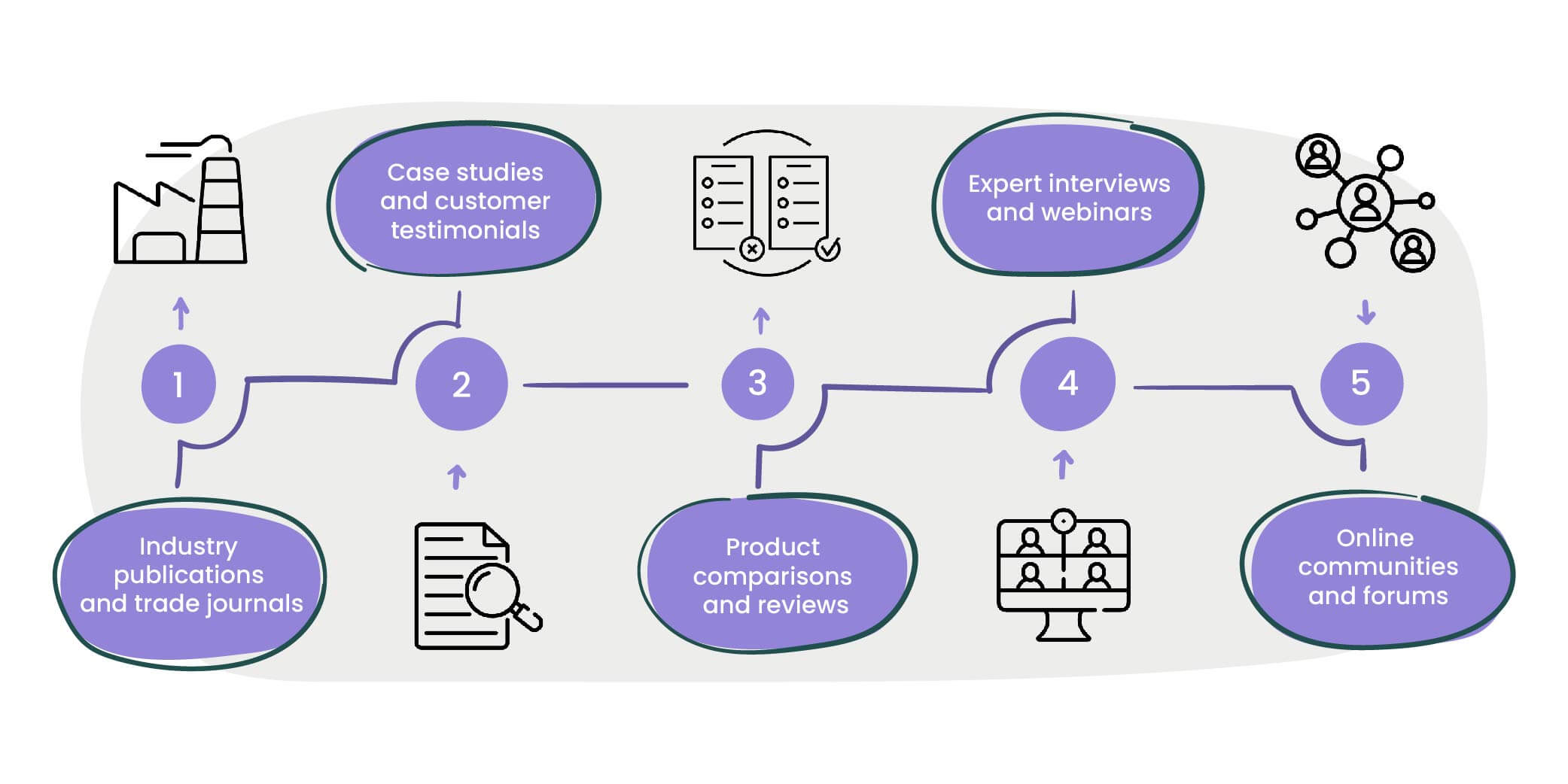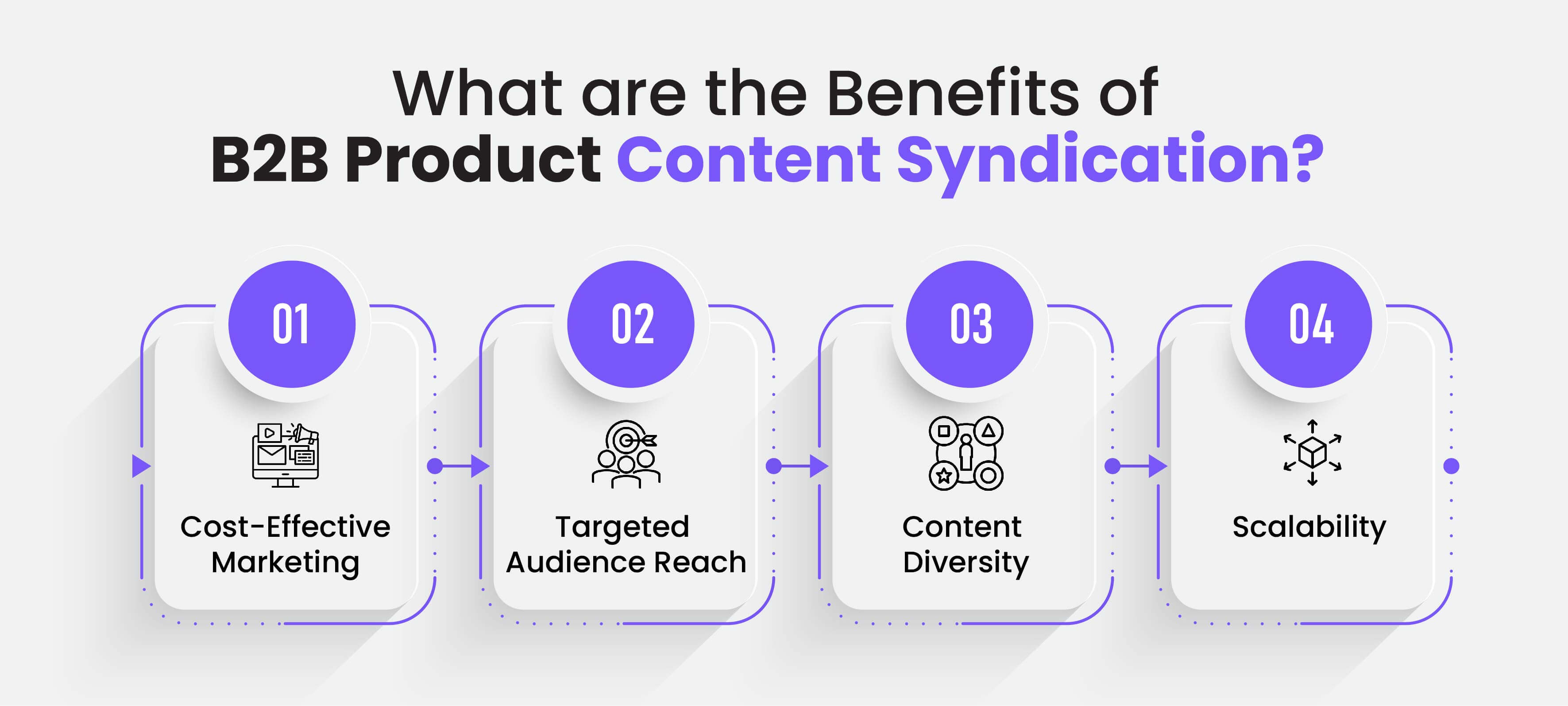“Make your customer the hero of your stories.” [Ann Handley, digital marketing pioneer]
We always resonate ‘hero’ with the good guy in the movies, TV shows, or books. However, in B2B marketing, positioning your product as the “savior” won’t necessarily win over customers. Instead, tell stories that resonate with their lives.
But how do you connect your business with your reader’s life story?
- Deeply understand your audience.
- Transform your outlook.
- Generate user-generated content.
In this blog we’ll explore:
- What B2B product content syndication is.
- Its benefits and importance.
- Common challenges and how to overcome them.
- Real-world examples of success.
By the end, you’ll be equipped to craft a winning B2B product content syndication strategy and leverage its growth potential.
But exactly B2B product content syndication is:
Mastering B2B Product Content Syndication: A Comprehensive Guide
Understanding B2B Product Content Syndication?
B2B product content syndication is the strategic process of republishing your B2B (business-to-business) product-related content. The content is distributed across various online platforms to showcase your product’s value across relevant, high-authority websites, industry publications, and online communities. This allows you to:
Target a wider audience:
Reach a broader base of potential customers beyond your immediate network, driving qualified leads interested in your product offering.
Boost brand awareness and product visibility:
Gain wider exposure for your product, increasing brand recognition and establishing it as a key player in the industry.
Position yourself as a thought leader:
Share valuable insights and expertise through content that educates potential customers about your product’s capabilities and its impact on their specific challenges.
Drive organic traffic and leads:
High-quality backlinks from credible websites improve your search engine ranking, propelling your product-focused content to the top of search results and attracting organic leads.
Cost-effective lead generation:
Leverage existing high-quality product content to generate leads without the need for constant content creation.
Must Read: What is B2B Content Syndication? A Comprehensive Guide
Distributing channels:

Content is republished on relevant online platforms such as:
- Industry publications and trade journals:
- Case studies and customer testimonials:
- Product comparisons and reviews:
- Expert interviews and webinars:
- Online communities and forums:
Why It Matters: Benefits of B2B Product Content Syndication
The importance of B2B product content syndication lies in its ability to:
- Expand Brand Reach: Reach a wider audience beyond your existing network, increasing brand awareness and recognition.
- Drive Website Traffic: Attract potential customers to your website by exposing them to your content on other platforms.
- Generate Qualified Leads: Capture leads from interested individuals who engage with your syndicated content.
- Build Brand Credibility: Establish your brand as a thought leader in your industry by showcasing your expertise through valuable content.
- Enhance SEO: Increase website visibility and organic search ranking through backlinks from reputable websites.
Must Read: Types of B2B Content Syndication
Common Challenges in Product Syndication (and How to Solve Them)
In the backdrop of the dynamic landscape of innovative technology and evolving consumer behaviors – marketers are facing the challenge of staying relevant among the internet noise. To tackle the challenges, we need to understand them upfront.
So, let’s delve into the challenges:
Identifying the Right Channels:
The abundance of B2B content syndication channels requires careful selection based on your unique goals to avoid diluting your message.
One size doesn’t fit all; you need to engage your audience with a curated message that speaks to the audience’s needs and demands. To truly engage, tailor your message to the specific audience and platform.
To simplify;
“Content Quality” x “Targeted Channel Selection” = “Increased Engagement.”
This showcases the importance of both content quality and strategic channel selection for driving audience engagement. Choosing the most effective channels for your content depends on your target audience, their online behavior, and your specific goals.
For instance, industry publications catering to your specific niche might be ideal for brand awareness- while social media platforms like LinkedIn could be excellent for lead generation.
Crafting Compelling Content:
Simply republishing existing content across various platforms won’t suffice. It’s crucial to tailor your content to resonate with the audience and platform specifics. Consider the platform’s tone, audience preferences, and format limitations when adapting your content.
Measuring Success:
Tracking the effectiveness of your syndication efforts requires identifying and monitoring relevant metrics. Website traffic, lead generation, brand mentions, and engagement metrics on the B2B content syndication platforms are all crucial indicators of success.
How to Create a Winning Syndication Strategy
Now, let’s explore practical steps to overcome these challenges and build a successful B2B product content syndication strategy,
Selecting the Right Channels:
- Target Audience First: Begin by understanding your target audience’s online behavior. Where do they spend their time online? What publications and platforms do they frequent? Utilize audience research tools offered by MarTech platforms to gain valuable insights.
- Align with Your Goals: Clearly define your objectives for content syndication. Do you aim for brand awareness, lead generation, or website traffic? Different channels cater to different objectives. For instance, MarTech platforms can help you identify content discovery platforms aligned with your target audience and marketing goals.
- Explore the Landscape: Research various syndication channels, including industry publications, social media platforms (LinkedIn, Twitter), content discovery platforms (Outbrain, Taboola), and online communities relevant to your niche.
Content Optimization:
- Maintain Brand Consistency: While adapting content for different platforms, ensure it reflects your brand voice and messaging. Consistency builds trust and recognition. Utilize content management systems with brand asset libraries to ensure consistent messaging across platforms.
- Leverage Visuals: Include high-quality visuals like infographics, charts, and images to enhance audience engagement and comprehension across platforms. Leverage platforms offer design tools and pre-built templates to create engaging visuals.
- Optimize for Readability:Tailor content length and complexity to suit the platform’s audience and format constraints. For instance, social media posts might require shorter, punchier content than in-depth white papers. Utilize tools that analyze content readability and suggest optimization strategies.
What are the Benefits of B2B Product Content Syndication?

Beyond the points mentioned above, B2B product content syndication offers several additional benefits:
- Cost-Effective Marketing: Leverage existing content to reach a wider audience without incurring significant additional costs.
- Targeted Audience Reach: Choose syndication channels frequented by your target audience for highly focused outreach.
- Content Diversity: Diversify your content marketing strategy by reaching new audiences and promoting different content formats.
- Scalability: Easily scale your reach by adding new syndication channels as your marketing efforts grow
Examples of B2B Product Content Syndication:
Here are some practical examples of how B2B companies can utilize product content syndication:
- A cybersecurity company syndicates a blog post on “The Latest Cybersecurity Threats and Solutions” on relevant industry publications.
- A marketing automation software company syndicates a white paper on “Boosting Lead Generation with Email Marketing” on content discovery platforms.
- A cloud storage provider syndicates a case study showcasing a successful customer story on a relevant business news website.
Now you may be wondering how to measure and track syndication success.
Let’s learn:
Measuring and Tracking Success:
Identify Key Metrics:
Define the metrics that align with your goals. This might include website traffic, lead generation, brand mentions, content downloads, and social media engagement metrics on the syndication platforms. Platforms offer analytics dashboards that allow you to track these metrics across various channels.
Utilize Tracking Tools:
Leverage analytics tools provided by the syndication platforms and your MarTech suite to monitor key metrics and gain valuable insights. Integrate marketing automation tools to capture leads generated from your syndicated content.
Data-Driven Optimization:
Analyze data regularly to identify what’s working and what’s not. Use these insights to refine your content strategy, channel selection, and optimization techniques. MarTech platforms offer advanced analytics and reporting tools to assist you in data-driven decision making.
Brands are winning big on content syndication, lets learn how successful companies bring their content in front of their audience:
Case Studies: B2B Companies Winning with Syndication
Let’s delve into the inspiring journeys of three B2B companies that have successfully utilized product content syndication to achieve their goals:
- Buffer: This social media management tool used content syndication on platforms like Entrepreneur, Forbes, and Inc. to reach a wider audience, resulting in significant website traffic growth and social media engagement. Their success highlights the power of strategic channel selection and content tailoring.
- Dell: This multinational tech giant leveraged content syndication on platforms like The Wall Street Journal, The New York Times, and PC World to promote their products and services. The resulting increase in website traffic and brand awareness demonstrates the effectiveness of syndication in building brand recognition.
- American Express: This financial services leader used content syndication on platforms like CNBC, CNN, and Bloomberg to reach a wider audience and promote their offerings. This significantly increased brand awareness and engagement.
Overall, in the quest for excellence and renewed approach on the content strategies and ROI—technology and human centric marketing approach is taking the center stage. Partner with best content syndication company and let your content consistently keeps you giving – ROI and revenue.
Frequently Asked Questions (FAQ)
What is B2B product content syndication?
B2B product content syndication is the process of distributing product-focused content—like datasheets, demos, and case studies—across third-party platforms to increase visibility, attract qualified leads, and drive product engagement.
How does product content syndication help in lead generation?
By publishing your product content on high-authority industry sites, you reach more potential buyers. When interested readers engage with your content, you can capture their details and qualify them as leads based on intent signals.
What types of content work best for product syndication?
The best formats include product datasheets, explainer videos, comparison guides, use-case articles, whitepapers, and customer success stories. These assets provide value and context for decision-makers evaluating solutions.
What channels are used for product content syndication?
Popular channels include:
- Industry publications (TechCrunch, CIO.com)
- B2B networks like LinkedIn
- Content discovery platforms like Outbrain or Taboola
- Email lists, forums, and product review sites like G2 or TrustRadius
Is B2B product content syndication SEO-friendly?
Yes. When done correctly with canonical tags or no-index directives, syndication can increase backlinks, brand mentions, and visibility—without causing duplicate content issues.
How do I measure the success of my syndication campaign?
Key metrics include:
- Referral traffic from syndication sources
- Lead volume and quality
- Engagement (downloads, views, clicks)
- Backlinks and domain authority growth
- ROI through conversion tracking
How is product syndication different from general B2B content syndication?
Product syndication focuses on content that highlights features, benefits, and use cases of your actual offerings, whereas general syndication might involve thought leadership or industry trend articles aimed at awareness rather than conversions.




